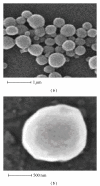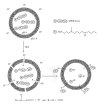Nanocarriers for nitric oxide delivery
- PMID: 21869934
- PMCID: PMC3159988
- DOI: 10.1155/2011/936438
Nanocarriers for nitric oxide delivery
Abstract
Nitric oxide (NO) is a promising pharmaceutical agent that has vasodilative, antibacterial, and tumoricidal effects. To study the complex and wide-ranging roles of NO and to facilitate its therapeutic use, a great number of synthetic compounds (e.g., nitrosothiols, nitrosohydroxyamines, N-diazeniumdiolates, and nitrosyl metal complexes) have been developed to chemically stabilize and release NO in a controlled manner. Although NO is currently being exploited in many biomedical applications, its use is limited by several factors, including a short half-life, instability during storage, and potential toxicity. Additionally, efficient methods of both localized and systemic in vivo delivery and dose control are needed. One strategy for addressing these limitations and thus increasing the utility of NO donors is based on nanotechnology.
Figures








Similar articles
-
Advances in inorganic-based colloidal nanovehicles functionalized for nitric oxide delivery.Colloids Surf B Biointerfaces. 2021 Mar;199:111508. doi: 10.1016/j.colsurfb.2020.111508. Epub 2020 Dec 4. Colloids Surf B Biointerfaces. 2021. PMID: 33340932 Review.
-
Nitric Oxide-Releasing Biomaterials for Biomedical Applications.Curr Med Chem. 2016;23(24):2579-2601. doi: 10.2174/0929867323666160729104647. Curr Med Chem. 2016. PMID: 27480214 Review.
-
Therapeutic Delivery of Nitric Oxide Utilizing Saccharide-Based Materials.ACS Appl Mater Interfaces. 2021 Nov 10;13(44):52250-52273. doi: 10.1021/acsami.1c10964. Epub 2021 Oct 29. ACS Appl Mater Interfaces. 2021. PMID: 34714640 Free PMC article. Review.
-
New Nitric Oxide Donors With Therapeutic Potential.Rev Med Chir Soc Med Nat Iasi. 2016 Oct-Dec;120(4):942-6. Rev Med Chir Soc Med Nat Iasi. 2016. PMID: 30141891
-
Nitric Oxide (NO)-Releasing Macromolecules: Rational Design and Biomedical Applications.Front Chem. 2019 Jul 26;7:530. doi: 10.3389/fchem.2019.00530. eCollection 2019. Front Chem. 2019. PMID: 31403044 Free PMC article. Review.
Cited by
-
Nanomolar Nitric Oxide Concentrations in Living Cells Measured by Means of Fluorescence Correlation Spectroscopy.Molecules. 2022 Feb 2;27(3):1010. doi: 10.3390/molecules27031010. Molecules. 2022. PMID: 35164275 Free PMC article.
-
Challenges and strategies for in situ endothelialization and long-term lumen patency of vascular grafts.Bioact Mater. 2020 Dec 5;6(6):1791-1809. doi: 10.1016/j.bioactmat.2020.11.028. eCollection 2021 Jun. Bioact Mater. 2020. PMID: 33336112 Free PMC article. Review.
-
In vivo pharmacological activity and biodistribution of S-nitrosophytochelatins after intravenous and intranasal administration in mice.Nitric Oxide. 2016 Sep 30;59:1-9. doi: 10.1016/j.niox.2016.06.006. Epub 2016 Jun 24. Nitric Oxide. 2016. PMID: 27350118 Free PMC article.
-
Enhanced Nitric Oxide Delivery Through Self-Assembling Nanoparticles for Eradicating Gram-Negative Bacteria.Adv Healthc Mater. 2024 Dec;13(32):e2403046. doi: 10.1002/adhm.202403046. Epub 2024 Sep 12. Adv Healthc Mater. 2024. PMID: 39263842 Free PMC article.
-
Nitric oxide-eluting nanocomposite for cardiovascular implants.J Mater Sci Mater Med. 2014 Mar;25(3):917-29. doi: 10.1007/s10856-013-5103-2. Epub 2013 Nov 30. J Mater Sci Mater Med. 2014. PMID: 24293239
References
-
- Waldman SA, Rapoport RM, Ginsburg R, Murad F. Desensitization to nitroglycerin in vascular smooth muscle from rat and human. Biochemical Pharmacology. 1986;35(20):3525–3531. - PubMed
-
- Butler AR. The biological roles of nitric oxide. Chemistry and Industry. 1995;20:828–830.
-
- Garthwaite J, Boulton CL. Nitric oxide signaling in the central nervous system. Annual Review of Physiology. 1995;57:683–706. - PubMed
-
- Ignarro LJ, Cirino G, Casini A, Napoli C. Nitric oxide as a signaling molecule in the vascular system: an overview. Journal of Cardiovascular Pharmacology. 1999;34(6):879–886. - PubMed
LinkOut - more resources
Full Text Sources
Other Literature Sources

